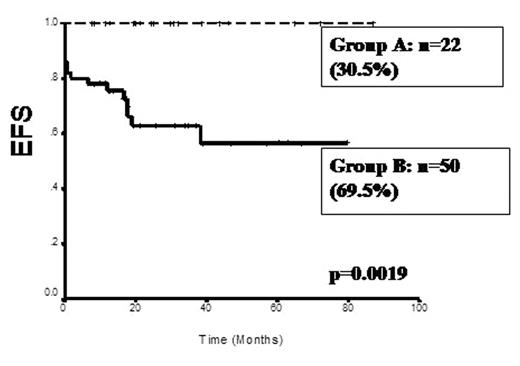Abstract
There is limited long term follow up data with the use of single agent As2O3 in the treatment of newly diagnosed cases of acute promyelocytic leukemia (APL).
Between January 1998 and December 2004, 72 newly diagnosed patients with APL were treated with single agent As2O3 administered in induction, consolidation and in maintenance at 10mg/day for adults and 0.15mg/kg/day for the pediatric population.
The mean age was 28.6 years (range: 3–75) with 38 (52.8%) males. Six patients (11.1%) received 1 – 2 doses of an anthracycline and 53 (73.6%) received hydroxyurea in induction for either onset of a differentiation syndrome or for leucocytosis. The regimen was well tolerated. Eight (11%) patients developed grade 3 – 4 toxicity (5-hepatic, 2-neuropathy and 1-prolonged neutropenia). None of these toxicities were irreversible or contributed to mortality. Grade 3 – 4 cytopenia did not occur in any patient in remission after the initial induction. Following the initial portion of induction the rest of the protocol was completed on an outpatient basis.
At a mean follow up of 31.4 months (range: 7.8–91) the EFS, DFS and OS was 70.19%, 90% and 81.33% respectively. In a univariate analysis of factors at diagnosis that had an adverse impact on survival a statistically significant effect was seen with a WBC >5000/mm3, Platelet <20,000/mm3 and a prolonged prothrombin time (PT) (p-values: 0.032, 0.020 and 0.023 respectively). In a multivariate analysis only a platelet count <20,000/mm3 retained its significant adverse impact. Prolonged PT, platelet <20,000/mm3 and WBC >5000/mm3 at diagnosis was seen in 12 (16.7%), 43 (59.7%) and 27 (37.5%) respectively. Using the WBC and platelet count at diagnosis two risk groups were identified, one with WBC <5000/mm3 and Platelet >20,000/mm3 (Group A, n=22[30.5%]) and the remaining patients (Group B, n=50[69.5%]). In group A the EFS and OS was 100% while in group B the EFS and OS was 56.5% and 73.33% respectively. Statistical analysis of the survival curves by log rank test between these two groups for EFS and OS was significant (p-values: 0.0019 and 0.0206 respectively) and there was a trend to significance for the DFS (p=0.079).
Conclusion: As2O3 is effective in the management of newly diagnosed cases of APL and can induce durable remissions. The regimen used in this study is well tolerated. Following remission induction it can be administered in the out-patient and has no irreversible or delayed toxicities. A subset that responds well to this regimen which has minimal toxicity can be identified and one could consider adding a synergistic agent such as ATRA or an anthracycline in the remaining patients.
Author notes
Corresponding author



